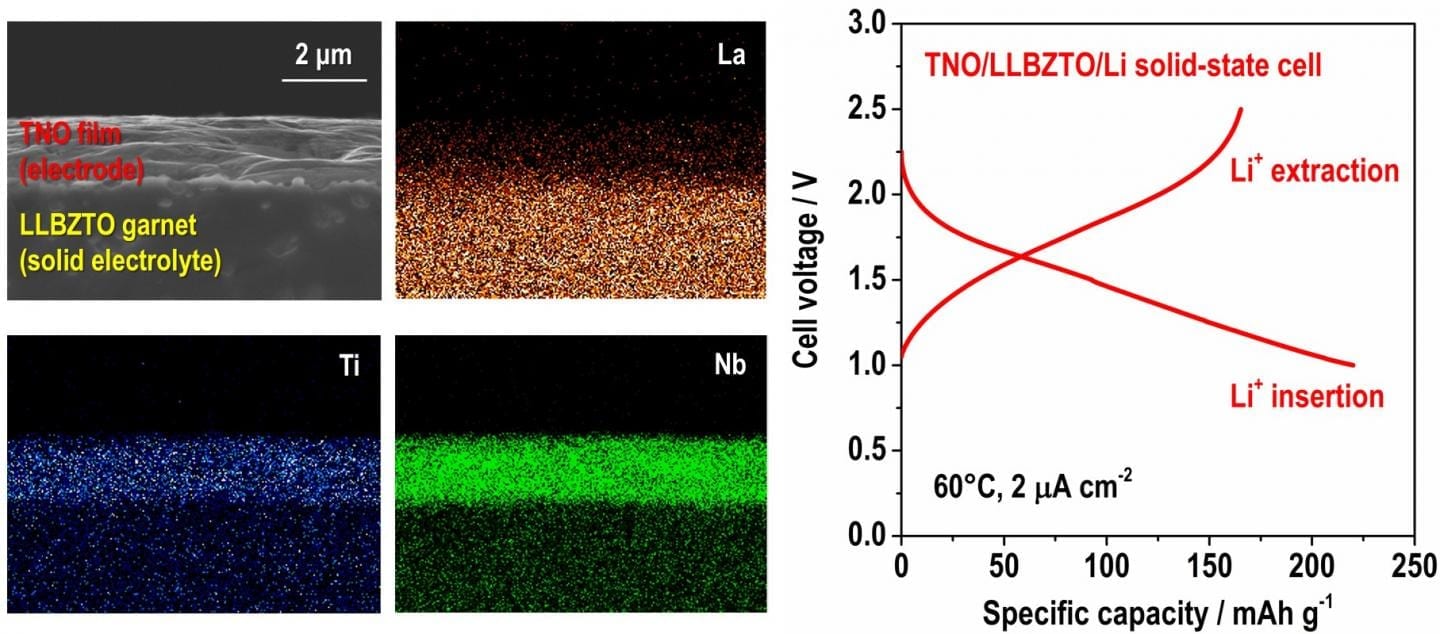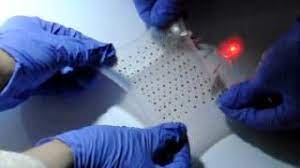
Advance could lead to improved battery safety, performance and cost
A team of researchers at the University of Maryland Energy Research Center and A. James Clark School of Engineering have announced a transformative development in the race to produce batteries that are at once safe, powerful, and affordable.
The researchers are developing game-changing solid-state battery technology, and have made a key advance by inserting a layer of ultra-thin aluminum oxide between lithium electrodes and a solid non-flammable ceramic electrolyte known as garnet. Prior to this advance, there had been little success in developing high-performance, garnet-based solid-state batteries, because the high impedance, more commonly called resistance, between the garnet electrolyte and electrode materials limited the flow of energy or current, dramatically decreasing the battery’s ability to charge and discharge.
The University of Maryland team has solved the problem of high impedance between the garnet electrolyte and electrode materials with the layer of ultrathin aluminum oxide, which decreases the impedance 300 fold. This virtually eliminates the barrier to electricity flow within the battery, allowing for efficient charging and discharging of the stored energy.
A new paper describing the research was published online December 19 in the peer-reviewed journal Nature Materials.
“This is a revolutionary advancement in the field of solid-state batteries—particularly in light of recent battery fires, from Boeing 787s to hoverboards to Samsung smartphones,” said Liangbing Hu, associate professor of materials science and engineering and one of the corresponding authors of the paper. “Our garnet-based solid-state battery is a triple threat, solving the typical problems that trouble existing lithium-ion batteries: safety, performance, and cost.”
Lithium-ion batteries typically contain a liquid organic electrolyte that can catch fire, as shown by numerous consumer electronic battery fires and even the temporary grounding of the Boeing 787 fleet for a series of battery fires. This fire risk is eliminated by the UMD team’s use of the non-flammable garnet-based solid-state electrolyte.
“The work by [the University of Maryland research team] effectively solves the lithium metal–solid electrolyte interface resistance problem, which has been a major barrier to the development of a robust solid-state battery technology,” said Bruce Dunn, UCLA materials science and engineering professor. Dunn, a leading expert in energy storage materials, was not involved in this research.
In addition, the high stability of these garnet electrolytes enable the team to use metallic lithium anodes, which contain the greatest possible theoretical energy density and are considered the ‘holy grail’ of batteries. Combined with high-capacity sulfur cathodes, this all solid-state battery technology offers a potentially unmatched energy density that far outperforms any lithium-ion battery currently on the market.
“This technology is on the verge of changing the landscape of energy storage. The broad deployment of batteries is critical to increase the flexibility of how and when energy is used, and these solid-state batteries will both increase the safety and decrease size, weight, and cost of batteries,” said Eric Wachsman, professor and director of the University of Maryland Energy Research Center and the other corresponding author of the paper.
“This [finding] is of considerable interest to those working to replace the flammable liquid electrolyte of the lithium-ion rechargeable battery with a solid electrolyte from which a lithium anode can be plated dendrite-free when a cell is being charged,” said acclaimed lithium-ion battery pioneer John B. Goodenough, Virginia H. Cockrell Centennial Chair in Engineering at the University of Texas, who was unaffiliated with the study. Read Goodenough’s full commentary on the Maryland team’s battery advance here.
Learn more: UMD Researchers Find Ultra-thin Solution to Primary Obstacle in Solid-State Battery Development
[osd_subscribe categories=’solid-state-rechargeable-batteries’ placeholder=’Email Address’ button_text=’Subscribe Now for any new posts on the topic “SOLID-STATE RECHARGEABLE BATTERIES”‘]
Receive an email update when we add a new SOLID-STATE RECHARGEABLE BATTERIES article.
The Latest on: Solid-state rechargeable batteries
[google_news title=”” keyword=”solid-state rechargeable batteries” num_posts=”10″ blurb_length=”0″ show_thumb=”left”]
via Google News
The Latest on: Solid-state rechargeable batteries
- ION Storage Systems to open nation’s largest solid-state battery facility in Beltsvilleon May 6, 2024 at 11:01 am
Listen to this article Solid-state battery manufacturer ION Storage Systems announced it will open the nation’s largest manufacturing facilities next to its headquarters in Beltsville. The battery ...
- Southern Company invests in solid-state battery companyon May 3, 2024 at 4:41 pm
Southern Company, through a subsidiary, has made an early-stage investment in Johnson Energy Storage (JES), an Atlanta-based solid-state battery company.
- Factorial and LG Chem to develop solid state battery materialson May 3, 2024 at 2:25 am
A new alliance has been created in the solid-state battery segment. Factorial Inc, a Massachusetts based company, specialised in high-performance solid-state ...
- Nio Is Launching Its 150 kWh Semi-Solid State Battery In June But It Can Only Be Rentedon April 30, 2024 at 3:29 am
Chinese media outlets claim the battery pack itself is worth roughly $45,000, hence the plan to rent instead of selling it with the car ...
- Unveiling the CATL solid-state battery routeon April 30, 2024 at 1:55 am
TrendForce has learned that at the CIBF2024 Advanced Battery Frontier Technology Symposium on April 28, Wu Kai, Chief Scientist of CATL, announced ...
- Best Rechargeable Hearing Aids Of 2024, According To Audiologistson April 29, 2024 at 10:39 pm
Rechargeable hearing aids are often a helpful solution, with batteries lasting more than 24 hours on a single charge in some models, plus Bluetooth compatibility, accompanying apps that host ...
- NIO begins public trials of its 150 kWh semi-solid-state battery packs ahead of a full rollouton April 29, 2024 at 8:36 am
Less than a month after beginning mass production of its new semi-solid-state battery packs, NIO has opened the technology ...
- CATL targets small-scale production of solid-state batteries by 2027: reporton April 29, 2024 at 4:10 am
CATL revealed on Monday that it is committed to the research and mass production of solid-state batteries, with the aim of achieving small-scale production by 2027.
- Breakthrough in Sodium Battery Chemistry Promises Lower Costson April 27, 2024 at 12:00 pm
A new mass synthesis process for sodium-containing sulfides could make all-solid-state sodium batteries more affordable and safer than lithium-ion batteries.
via Bing News











